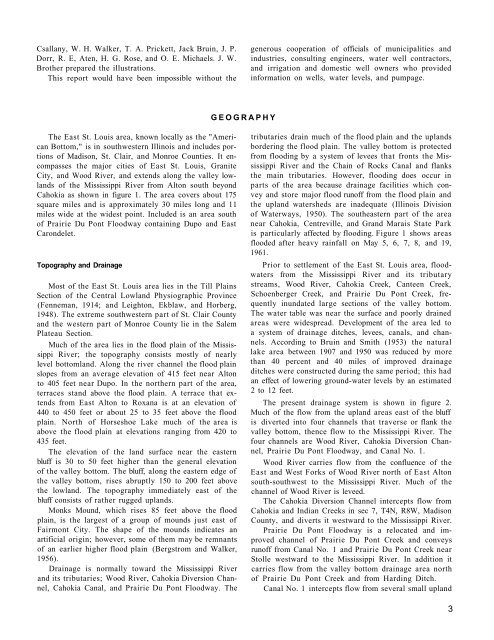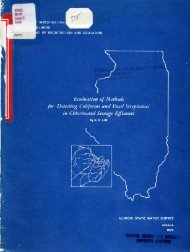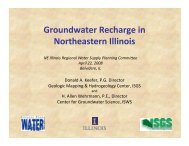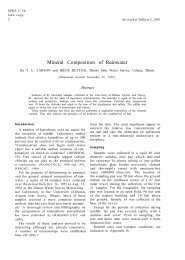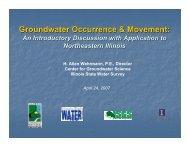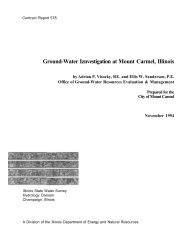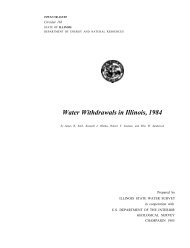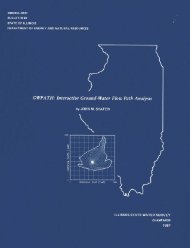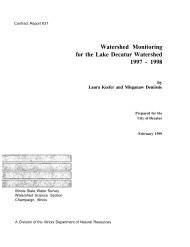Ground-water development in East St. Louis area, Illinois. Urbana, IL ...
Ground-water development in East St. Louis area, Illinois. Urbana, IL ...
Ground-water development in East St. Louis area, Illinois. Urbana, IL ...
Create successful ePaper yourself
Turn your PDF publications into a flip-book with our unique Google optimized e-Paper software.
Csallany, W. H. Walker, T. A. Prickett, Jack Bru<strong>in</strong>, J. P.<br />
Dorr, R. E, Aten, H. G. Rose, and O. E. Michaels. J. W.<br />
Brother prepared the illustrations.<br />
This report would have been impossible without the<br />
generous cooperation of officials of municipalities and<br />
<strong>in</strong>dustries, consult<strong>in</strong>g eng<strong>in</strong>eers, <strong>water</strong> well contractors,<br />
and irrigation and domestic well owners who provided<br />
<strong>in</strong>formation on wells, <strong>water</strong> levels, and pumpage.<br />
GEOGRAPHY<br />
The <strong>East</strong> <strong>St</strong>. <strong>Louis</strong> <strong>area</strong>, known locally as the "American<br />
Bottom," is <strong>in</strong> southwestern Ill<strong>in</strong>ois and <strong>in</strong>cludes portions<br />
of Madison, <strong>St</strong>. Clair, and Monroe Counties. It encompasses<br />
the major cities of <strong>East</strong> <strong>St</strong>. <strong>Louis</strong>, Granite<br />
City, and Wood River, and extends along the valley lowlands<br />
of the Mississippi River from Alton south beyond<br />
Cahokia as shown <strong>in</strong> figure 1. The <strong>area</strong> covers about 175<br />
square miles and is approximately 30 miles long and 11<br />
miles wide at the widest po<strong>in</strong>t. Included is an <strong>area</strong> south<br />
of Prairie Du Pont Floodway conta<strong>in</strong><strong>in</strong>g Dupo and <strong>East</strong><br />
Carondelet.<br />
Topography and Dra<strong>in</strong>age<br />
Most of the <strong>East</strong> <strong>St</strong>. <strong>Louis</strong> <strong>area</strong> lies <strong>in</strong> the Till Pla<strong>in</strong>s<br />
Section of the Central Lowland Physiographic Prov<strong>in</strong>ce<br />
(Fenneman, 1914; and Leighton, Ekblaw, and Horberg,<br />
1948). The extreme southwestern part of <strong>St</strong>. Clair County<br />
and the western part of Monroe County lie <strong>in</strong> the Salem<br />
Plateau Section.<br />
Much of the <strong>area</strong> lies <strong>in</strong> the flood pla<strong>in</strong> of the Mississippi<br />
River; the topography consists mostly of nearly<br />
level bottomland. Along the river channel the flood pla<strong>in</strong><br />
slopes from an average elevation of 415 feet near Alton<br />
to 405 feet near Dupo. In the northern part of the <strong>area</strong>,<br />
terraces stand above the flood pla<strong>in</strong>. A terrace that extends<br />
from <strong>East</strong> Alton to Roxana is at an elevation of<br />
440 to 450 feet or about 25 to 35 feet above the flood<br />
pla<strong>in</strong>. North of Horseshoe Lake much of the <strong>area</strong> is<br />
above the flood pla<strong>in</strong> at elevations rang<strong>in</strong>g from 420 to<br />
435 feet.<br />
The elevation of the land surface near the eastern<br />
bluff is 30 to 50 feet higher than the general elevation<br />
of the valley bottom. The bluff, along the eastern edge of<br />
the valley bottom, rises abruptly 150 to 200 feet above<br />
the lowland. The topography immediately east of the<br />
bluff consists of rather rugged uplands.<br />
Monks Mound, which rises 85 feet above the flood<br />
pla<strong>in</strong>, is the largest of a group of mounds just east of<br />
Fairmont City. The shape of the mounds <strong>in</strong>dicates an<br />
artificial orig<strong>in</strong>; however, some of them may be remnants<br />
of an earlier higher flood pla<strong>in</strong> (Bergstrom and Walker,<br />
1956).<br />
Dra<strong>in</strong>age is normally toward the Mississippi River<br />
and its tributaries; Wood River, Cahokia Diversion Channel,<br />
Cahokia Canal, and Prairie Du Pont Floodway. The<br />
tributaries dra<strong>in</strong> much of the flood pla<strong>in</strong> and the uplands<br />
border<strong>in</strong>g the flood pla<strong>in</strong>. The valley bottom is protected<br />
from flood<strong>in</strong>g by a system of levees that fronts the Mississippi<br />
River and the Cha<strong>in</strong> of Rocks Canal and flanks<br />
the ma<strong>in</strong> tributaries. However, flood<strong>in</strong>g does occur <strong>in</strong><br />
parts of the <strong>area</strong> because dra<strong>in</strong>age facilities which convey<br />
and store major flood runoff from the flood pla<strong>in</strong> and<br />
the upland <strong>water</strong>sheds are <strong>in</strong>adequate (Ill<strong>in</strong>ois Division<br />
of Waterways, 1950). The southeastern part of the <strong>area</strong><br />
near Cahokia, Centreville, and Grand Marais <strong>St</strong>ate Park<br />
is particularly affected by flood<strong>in</strong>g. Figure 1 shows <strong>area</strong>s<br />
flooded after heavy ra<strong>in</strong>fall on May 5, 6, 7, 8, and 19,<br />
1961.<br />
Prior to settlement of the <strong>East</strong> <strong>St</strong>. <strong>Louis</strong> <strong>area</strong>, flood<strong>water</strong>s<br />
from the Mississippi River and its tributary<br />
streams, Wood River, Cahokia Creek, Canteen Creek,<br />
Schoenberger Creek, and Prairie Du Pont Creek, frequently<br />
<strong>in</strong>undated large sections of the valley bottom.<br />
The <strong>water</strong> table was near the surface and poorly dra<strong>in</strong>ed<br />
<strong>area</strong>s were widespread. Development of the <strong>area</strong> led to<br />
a system of dra<strong>in</strong>age ditches, levees, canals, and channels.<br />
Accord<strong>in</strong>g to Bru<strong>in</strong> and Smith (1953) the natural<br />
lake <strong>area</strong> between 1907 and 1950 was reduced by more<br />
than 40 percent and 40 miles of improved dra<strong>in</strong>age<br />
ditches were constructed dur<strong>in</strong>g the same period; this had<br />
an effect of lower<strong>in</strong>g ground-<strong>water</strong> levels by an estimated<br />
2 to 12 feet.<br />
The present dra<strong>in</strong>age system is shown <strong>in</strong> figure 2.<br />
Much of the flow from the upland <strong>area</strong>s east of the bluff<br />
is diverted <strong>in</strong>to four channels that traverse or flank the<br />
valley bottom, thence flow to the Mississippi River. The<br />
four channels are Wood River, Cahokia Diversion Channel,<br />
Prairie Du Pont Floodway, and Canal No. 1.<br />
Wood River carries flow from the confluence of the<br />
<strong>East</strong> and West Forks of Wood River north of <strong>East</strong> Alton<br />
south-southwest to the Mississippi River. Much of the<br />
channel of Wood River is leveed.<br />
The Cahokia Diversion Channel <strong>in</strong>tercepts flow from<br />
Cahokia and Indian Creeks <strong>in</strong> sec 7, T4N, R8W, Madison<br />
County, and diverts it westward to the Mississippi River.<br />
Prairie Du Pont Floodway is a relocated and improved<br />
channel of Prairie Du Pont Creek and conveys<br />
runoff from Canal No. 1 and Prairie Du Pont Creek near<br />
<strong>St</strong>olle westward to the Mississippi River. In addition it<br />
carries flow from the valley bottom dra<strong>in</strong>age <strong>area</strong> north<br />
of Prairie Du Pont Creek and from Hard<strong>in</strong>g Ditch.<br />
Canal No. 1 <strong>in</strong>tercepts flow from several small upland<br />
3


